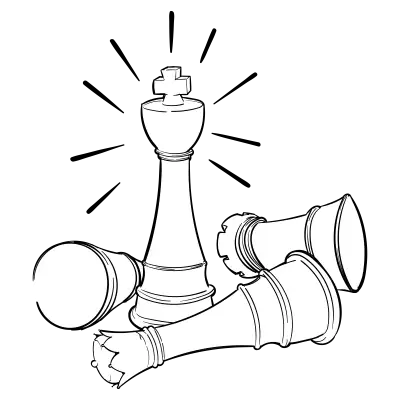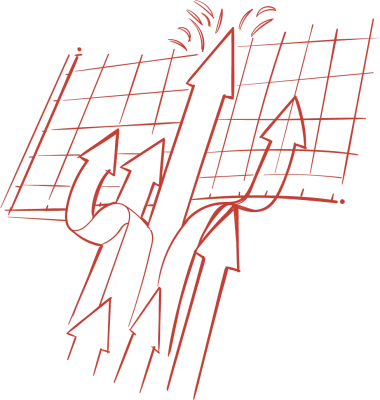Kris' Far Out Far Out Fundamentals
Kris Mariani.
As Drive’s creative director and resident carpenter, Kris knows what it means to really put his back into it when it comes to meeting a client’s needs. He knows that no matter the time, place or weather, you gotta do what you gotta do to get the job done and pray to Ol’ Man Winter that it’s not on a powder day.
What advice do you have for someone who’s leading a creative project for the first time?
Well, first, I'd like to back up and say that my knees are off-limits, as well. Being a skier, that's kind of a dangerous thing. Now you can go after my head or anything like that, all you want, but just leave my knees off limits, okay? Alright.
So not knowing how much experience a person might have...because obviously, having a bit of experience is having a really good understanding for the client or the product, who the target audience is and what the purpose of the creative project is. So I think understanding all those things is going to lead to better success in the execution of the project.
How does being a creative director for a small agency, like Drive, differ from a larger agency?
There are a few things. I think you get your hands dirty, per se, a bit more as a creative director in a small agency. And the other big thing is, you're involved with the entire client list, as opposed to being the creative director for say... two accounts or three accounts. So you're involved in a lot more and you don't do the traditional tasks that I think are normally associated with a creative director. One thing I love doing is my own physical building–my own physical mock-ups–for presentations, or mounting boards or whatever. I enjoy that process of it, the “arts and crafts” process of it. Whereas in a big agency, you would never see a creative director doing stuff like that.
Do you have any tips for managing a client's expectations, and making sure you deliver?
Well, this goes back to that first question, which is understanding the client, the product and the target. Having a really deep understanding, so that you're delivering something authentic to that product and to the client. Another big part is making the client feel involved in the process, so understanding the things that they like, and that they don't like. If they're involved throughout the whole process, no matter what you're working on with them, they're gonna have greater buy-in when they see the end result. So I think it's easier to succeed and meet their expectations when they feel like you've listened to them. And then when they see it, or they hear it, whatever it is you're working on for them, they feel like they were listened to. That's really the important thing
Can you talk about a time you went the extra mile for a client?
Well, the lights went out. They couldn't get the lights to work. And we're all in our fancy gear,Carter and I went out there,got a ladder and some pliers, and we got the lights back on for them.
Well! We had one client–have one client–that we'd done a rebrand for them and everything and it came time for them to do a tradeshow booth. They had a certain budget and it was a pretty big space that they were working in. They had refrigeration units and stuff that needed to be incorporated into this, and we needed to display product on some sort of shelving or something.
We developed a booth that was basically based off of like an urban market, if you will–an outdoor urban market–so kind of the brick feel, wood crate-y type thing and whatnot. In order to stay within budget for this wall of shelving, I sourced the kind-of-cool pipe structure that the shelving would be on. Then I went out and actually bought the lumber to create the shelves. I brought them home–it was in winter–and I routed them, at home, to round the edges of them, stain them and everything. Then, not wanting to just trust that the measurements I was given were okay, I went down to the show to install and brought my saw with me in case I needed to make alterations to the shelves. Sure enough I did, so I went down, help them build the booth and then went behind a curtain to try to escape all the union staff and whatnot (who were there to make sure people weren’t doing exactly that) and proceeded to rip an inch and a half off of each of these shelves and reinstall them. So that would be, I guess, one instance.
Another instance would be, we were doing a fundraising event for a client and we're all dressed to the nines! It was kind of a themed event, where you get dressed up. The outdoor area, where they were having some of the event, had nice string lighting and whatnot... Well, the lights went out. They couldn't get the lights to work. And we're all in our fancy gear and a coworker, Carter, and I went out there, got a ladder and some pliers, and we got the lights back on for them.
Once that was over, the event started and there was a live band and there was supposed to be dancing. It was kind of slow to progress, so we got out on the dance floor and we decided to be the hype crew and we got the place hoppin’.
So we turned the lights on and we got the place hoppin’! So that’s a fun above-and-beyond for a client.
Specifically for working with clients during a pandemic or just clients that are based in different regions, how do you make sure they see the work when you can’t meet or work together in person?
So I think technology has already made the solution to this easy. It's very easy to send digital proofs, whether it be video or a 24-page booklet or something. It's pretty easy now to send work to clients. We've got clients in Texas and Colorado and it's very easy for us to share our work.
I think the important thing now–and it's kind of the obvious with the pandemic–is making sure they can see you and that you're in touch with them regularly. They like to see your smiling face, whether it's Zoom or one of the other options out there.
I think also, the important thing is if you say to a client, “Hey, the first draft will take two weeks.” Touch base with them–because of the pandemic–and just keep them in the loop and continue to communicate with them. Don't disappear for two weeks, if it's going to take two weeks.
Is there anything you’d like to add?
I would say my final point would be... when it comes to campaign messaging or design, it's really about creating something that's going to resonate with the target audience, and be authentic to the product. It's not about creating something, or writing something, that other agencies or other creatives think is cool, or that you think is cool, unless you're the target, of course. It really is about the target. Sometimes we have ideas and we think they're phenomenal, but then when you relate it to who you're trying to appeal to or who you're trying to resonate with, it may not be the right thing, so just understand that.
All told, here are a few of Kris’ takeaways for surpassing clients’ expectations:
- Understanding the client’s needs for a project will better set you up for success.
- No matter the role you have, never be afraid to get your hands dirty.
- It is easier to succeed when your clients feel they are heard.
- Stay in touch with clients as often as possible is important—and easier—now more than ever. Thanks, #technology!
- Always-ALWAYS! Go with the idea that will most resonate with the target audience, even if you think a different idea is better.







